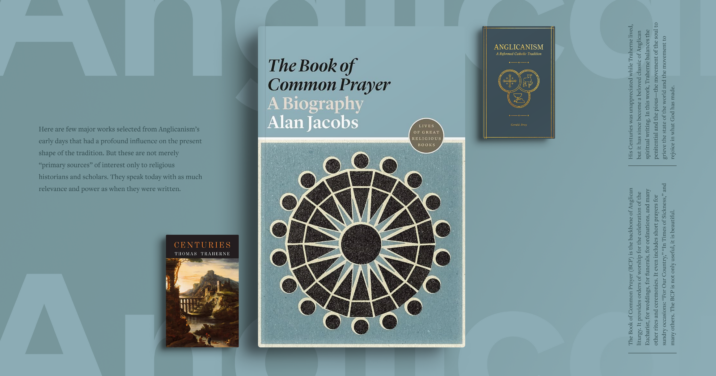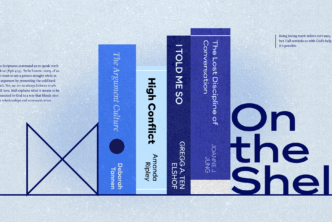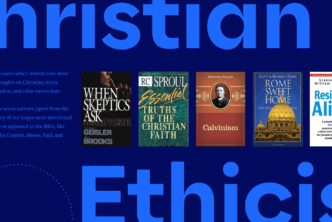I grew up in the church, just not an Anglican church. My journey into the Anglican fold is a story for another time, but I bring it up here because that experience strongly informs this selection of Anglican books you should know. These books were chosen not just for their accuracy and acumen, but also because I think they are suited to people who might be as I was: knowing little about Anglicanism and wanting to know more.
I commend this list as an “Anglican Starter Pack” and nothing more. It is not a rundown of “the best books” in the tradition (though if such a list were to exist, some of these titles would be included there), nor does it attempt to offer a representation of the whole swath of Anglican tradition—which is far more varied than a list of this size could manage. It is a modest sampling to get you started. But if you manage to work through the whole list, you will be well-rounded in the essentials of traditional Anglican history, doctrine, liturgy, and spirituality.
Major primary sources
Here are few major works selected from Anglicanism’s early days that had a profound influence on the present shape of the tradition. But these are not merely “primary sources” of interest only to religious historians and scholars. They speak today with as much relevance and power as when they were written.
1. The Book of Homilies
Along with the Thirty-Nine Articles, the Book of Common Prayer, and the Ordinal, the Book of Homilies is the fourth of the basic historic formularies of Anglicanism. This work is of considerable importance for understanding both Anglican history and doctrine. Published in two volumes in 1547 and 1563, the purpose of the Book of Homilies was to alleviate a crisis in pastoral education. The state of the priesthood inherited by the Church of England was dire. Before the Reformation, most clergy were poorly educated and opted out of preaching, instead focusing on the ritualistic observance of the Mass. With reform came an emphasis on the reading, exposition, and application of Scripture; but it would take time to produce clergymen who were up to the task. So in the interim, to ensure that the Word was preached every Sunday, copies of the Book of Homilies were distributed to churches so that resident priests could select a homily to read aloud. Today, the Book of Homilies remains obscure, despite being a treasure house of early Anglican pastoral teaching.1
2. An Apology of the Church of England, by John Jewel
John Jewel (1522–1571) was Bishop of Salisbury and a leading architect of the Church of England in its Elizabethan days, while it was still new and fragile. Catholics both at home and abroad accused the Church of England of heresy and pushed for a reintegration with Rome. Jewel argued powerfully on behalf of the Reformation and Protestant teaching. He denied that Protestants were heretics or innovators. Rather, they were a dynamic within the historic church to recover authentic catholicity by restoring the church to the purity of the faith once delivered to the saints. While he defends the Church of England in particular, Jewel’s classic remains the definitive defense of the Reformation generally, as well as a key text to Anglican ecclesial identity.
3. The Laws of Ecclesiastical Polity, by Richard Hooker
Anglicanism has no eponymous theologian. There is no one who is for Anglicans what John Calvin is for Calvinists, or Martin Luther for Lutherans. But if you were to force the question, the Elizabethan priest Richard Hooker (1554–1600) would be a strong candidate. His classic work appeared at an existential moment in the Church of England’s history. The first generation of Reformers in England had died off, and a new generation was reassessing the state of the Church. To simplify, one group looked backwards to the separation from Rome with regret; another group, the Puritans, believed the earlier Reformers had not taken the principles of the Reformation far enough, and looked ahead to even further reform. Hooker proposed a middle way. While defending the Reformation, he believed Christianity’s Catholic heritage should not be rejected wholesale. Using Scripture and insights from the early ecumenical councils, he deftly addressed the doctrinal controversies of his day, forging a way ahead for Anglicanism to be both Catholic and Reformed. Hooker is thus a significant contributor to how Anglicanism would come to define itself, and this work is a landmark of Anglican theology.2
Richard Hooker on Anglican Faith and Worship: Of the Laws of Ecclesiastical Polity: Book V
Regular price: $35.99
4. The Private Devotions, by Lancelot Andrewes
The Book of Common Prayer is, famously, the prayerbook of Anglicanism. And while many people use it for their private devotions, this is not technically its purpose. As the word common denotes, the BCP is intended for a communal setting. But if you want a classic Anglican expression of solitary, individual prayer, you couldn’t do better than The Private Devotions of Lancelot Andrewes (1555–1626). Andrewes was Bishop of Winchester and one of the secretaries of the group of forty-seven translators tasked with translating the Authorized Bible (i.e., the King James Bible). His deep familiarity with Scripture is on full display in his Private Devotions, which resembles less an original composition than a compilation of biblical verses and phrases, selected and woven together into a personal prayer. The Bible was Andrewes’s prayer-vernacular: whatever his feelings of joy or contrition, he looked to the Bible to supply him with the language he needed. The core of his Private Devotions is a series of devotions for each day of the week, corresponding to God’s creative activity on that day as recorded in Genesis 1. All follow the same structure: praise, confession (of sin), profession (of faith), intercession, and finally thanksgiving.
The Devotions of Bishop Andrewes, Translated from the Greek, and Arranged Anew
Regular price: $7.49
5. Centuries, by Thomas Traherne
An amateur book collector paid a few pence for a pair of early modern manuscripts in the winter of 1896/97. The manuscripts were later identified to be the work of an obscure Anglican cleric and poet, Thomas Traherne (c. 1636–1674)—but he would be obscure no longer. His Centuries was unappreciated while Traherne lived, but it has since become a beloved classic of Anglican spiritual writing. In this work, Traherne balances the penitential and the pious—the movement of the soul to grieve the state of the world and the movement to rejoice in what God has made: “To contemn the world and to enjoy the world are things contrary to each other. How then can we contemn the world, which we are born to enjoy? Truly there are two worlds. One was made by God, the other by men.”3 Traherne’s answer is that we must love the world God has made, and we must learn to love it as God loves it. Here, sin manifests itself primarily as ingratitude, which in turn is a failure to properly see and appreciate Creation. In Traherne, we find a magnificent antidote to the latent Gnosticism of modernity, which looks on the world with contempt, as a lost cause, and denies that such a world can be our God-given home.
6. Readings in St. John’s Gospel, by William Temple
William Temple (1881–1944) was an English priest. Over the course of his vocation, he served as Bishop of Manchester, Archbishop of York, and Archbishop of Canterbury. No writer would have a greater influence on the popular religious mind of Anglicans until John Stott. This work, Readings in St. John’s Gospel, in particular, would be a staple for several generations of Anglican clergy and laypeople, found in seminary courses and basement book clubs alike. Rowan Williams describes it aptly: “It manages to be both more and less than a commentary in the normal sense: it offers a variety of observations on specific questions of exegesis, but is more of a protracted meditation on the text, of the kind that kindles intelligent devotion.”4 Temple understood that the gospel is not just an ancient eyewitness report, but a Spirit-possessed narrative that is always contemporaneous with its reader, speaking into our lives with power. In Readings, we find Temple’s oft-quoted aphorism: “Christianity is the most materialistic of all great religions,”5 for divine revelation is never unmediated, but arrives to us always clothed in the grit and stink of real history, in the typo-riddled transmission of real manuscripts, and in the deeds and speech of real flesh and blood.
Introductions to key subjects
While going to the sources—particularly its preaching and commentaries—is always the best approach to understand a tradition, many will require readable secondary sources by those who’ve already done so. Here are some general introductions to some major facets of Anglicanism. In descending order: the Thirty-Nine Articles, Anglican ascetical theology, the Book of Common Prayer, and Anglican liturgy.
7. Anglicanism: A Reformed Catholic Tradition, by Gerald Bray
This short work advertises itself as an introduction to historic Anglican belief and identity. While technically true, it is more an introduction to a major document of historic Anglican doctrine: the Thirty-Nine Articles. Anglicanism lacks a historic confession of faith comparable to what the Westminster Confession (1647) is for many Presbyterians, or the Augsburg Confession (1530) for Lutherans. The Thirty-Nine Articles comes closest—but it is less a formal confession than a delineation of the main points that caused the Church of England to remain independent of Rome. Most editions of the BCP include the Articles as an appendix, and in wider Anglican circles they are still cited as a touchstone of Anglican orthodoxy. Interest in the Articles has grown in recent years, both in ecumenical discussions and in global Anglican contexts, and ignoring them in a definition of Anglicanism is no longer acceptable. For a longer and more thorough exposition of the Articles by the same author, see The Faith We Confess.
8. English Spirituality: An Outline of Ascetical Theology according to the English Pastoral Tradition, by Martin Thornton
When we become Christians, we find ourselves with a new set of friends in heaven and on earth. We also find ourselves with a new set of enemies: the world, the flesh, and the devil. The Christian life requires we struggle against the forces which oppose or obstruct our ever-deepening union with Christ and his church. The traditional word for this spiritual struggle is asceticism, from the Greek askesis, which referred to the “exercise” or “training” an athlete would undergo to prepare for a contest. (Paul also uses the analogy of the athlete to exhort his readers to greater self-discipline; 1 Cor 9:24–27.) In this classic work on Anglican ascetical theology, at once a history and a treatise of the subject, Martin Thornton defines the spiritual life as “one in which the spirit of God, sought and nurtured in prayer, controls its every minute and every aspect.” Similarly, “ascetical theology is primarily a practical approach to all other branches of theology, a catalyst or synthesizing agent which welds all the departments into a creative whole.”6 In short, asceticism is the dynamic that unites our theology with our lives, converting us into people of religious integrity—and the tradition of spiritual formation coming out of “English Christianity” (i.e., Anglicanism) is a distinct and effective path to become such a Christian.
English Spirituality: An Outline of Ascetical Theology According to the English Pastoral Tradition
Regular price: $23.99
9. The Book of Common Prayer: A Biography, by Alan Jacobs
The Book of Common Prayer (BCP) is the backbone of Anglican liturgy. It provides orders of worship for the celebration of the Eucharist, for weddings, for funerals, for ordinations, and many other rites and ceremonies. It even includes short prayers for sundry occasions: “For Our Country,” “For a Birthday,” “In Times of Sickness,” and many others. The BCP is not only useful, it is beautiful. So beautiful, in fact, that non-Anglicans often use it for their own ceremonies. For example, not everyone realizes that the popular vows made at weddings—“to have and to hold from this day forward, for better for worse, for richer for poorer, in sickness and in health, to love and to cherish, till death us do part”—comes directly from the 1789 BCP.
How did the BCP come to be? Who wrote it? How is it used? What’s the difference between its many versions, and how do I choose? What’s its cultural impact, its theology, and its role in controversies? These and many other questions are answered in this short but celebrated history of the BCP.
While you’re looking at that, grab a copy of the BCP 1662, if you don’t own one already:
10. Anglican Public Worship, by Colin Dunlop
As a host of recent books has shown, a great deal of interest in Anglicanism concerns its liturgy.7 More and more evangelicals, fatigued by the whims of contemporary worship trends and go-it-yourself devotionals, are longing for a stronger historical connection with the faith. However, the spiritual and theological frame that accompanies liturgical tradition can seem strange, even off-putting. Dunlop’s brief but bright work, Anglican Public Worship, originally published in 1953, has become the standard introduction to the subject. Readers will learn why public worship is so important, and why private worship, while beneficial, is no substitute. Readers will also learn why the liturgy looks the way it does and not some other way. A key point of Dunlop’s theology of liturgy is that worship is not a means to some earthly good—even great goods like living more morally the rest of the week. Rather, worship is, first and foremost, something we give to God which orients us toward his eternal kingdom.
Explore our Anglican Libraries
Related articles
- Anglican History: Reformed, Catholic, or Confused
- Anglican Bible Study: The Major Books, Thinkers, and Principles
- The Definitive Guide to Christian Denominations
- To draw academic interest in this work, Gerald Bray has recently produced a critical edition.
- If you find it difficult to read lofty sixteenth-century vernacular, Brad Littlejohn has recently produced a modernized edition of Hooker’s The Laws of Ecclesiastical Polity.
- Thomas Traherne, Centuries (Angelico Press, 2020), 1.7.
- Rowan Williams, Anglican Identities (Cowley Publications, 2003), 130.
- William Temple, Readings in St. John’s Gospel (Macmillan and Co., 1949), xx.
- Martin Thornton, English Spirituality: An Outline of Ascetical Theology according to the English Pastoral Tradition (Wipf & Stock Publishers, 1986), 16.
- See, for example, the story of a man from being a Jesus People movement leader to an Anglican bishop, Todd D. Hunter, The Accidental Anglican: The Surprising Appeal of the Liturgical Church (InterVarsity Press, 2010).






